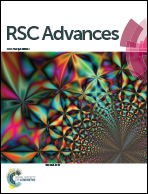Reaction-induced microphase separation in DDS-cured TGDDM thermosets containing PCL-b-PES-b-PCL triblock copolymer
Abstract
A triblock copolymer, poly(ε-caprolactone)-block-poly(ether sulfone)-block-poly(ε-caprolactone) (PCL-b-PES-b-PCL), was synthesized by the ring-opening polymerization of hydroxyl-terminated poly(ether sulfone) and ε-caprolactone monomer. The triblock copolymer was characterized via Fourier transform infrared spectroscopy (FTIR), nuclear magnetic resonance spectroscopy (NMR) and gel permeation chromatography (GPC). The PCL-b-PES-b-PCL triblock copolymer was introduced into a N,N,N′,N′-tetraglycidyl-4,4′-diaminodiphenyl methane (TGDDM) epoxy matrix cured with 4,4′-diaminodiphenylsulfone (DDS). The nanostructures were evidenced by means of atomic force microscopy (AFM), transmission electron microscopy (TEM) and small-angle X-ray scattering (SAXS). It was found that PCL nanophases were formed in the thermosets and the average distance between the neighboring nano-domains was calculated by the equation L = 2π/qm. The thermal stability and mechanical performance of the TGDDM thermosets were improved owing to the incorporation of the PCL-b-PES-b-PCL triblock copolymer. It was judged that the formation of the nanostructure followed the mechanism of reaction-induced microphase separation.


 Please wait while we load your content...
Please wait while we load your content...